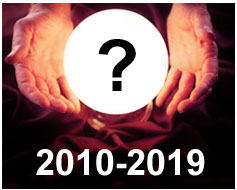Vol. 9, Issue No. 1: JANUARY 2010 – EXECUTIVE SUMMARYHealthcare Communications vs. Pharma Marketing Upfront Commentary
 Whenever someone refers to a pharmaceutical company as a “healthcarecompany” the hairs on the back of my neck (where I still have somehair) rise up. This often happens when I speak to agencies that doconsulting work for pharmaceutical companies and talk about “healthcarecommunications” when they actually mean pharmaceutical marketing.
Whenever someone refers to a pharmaceutical company as a “healthcarecompany” the hairs on the back of my neck (where I still have somehair) rise up. This often happens when I speak to agencies that doconsulting work for pharmaceutical companies and talk about “healthcarecommunications” when they actually mean pharmaceutical marketing.
Are pharmaceutical companies healthcare companies? Should we replace”pharmaceutical marketing” with “healthcare communications?”
Read this entire OpEd piece by John Mack here:
www.news.pharma-mkting.com/PMNews_91_UpFront.pdf Predicting the Future of the Drug Industry What’s in Store for the Next Decade?
 Every new year we either take a look back or ahead one year. Many people would rather forget about 2009 and look forward to better times in 2010. But what about looking even farther into the future? Since we just finished the first decade of the 21st century, why not look into our crystal balls to predict what the next decade (2010-2019) holds in store for the pharmaceutical industry.
Every new year we either take a look back or ahead one year. Many people would rather forget about 2009 and look forward to better times in 2010. But what about looking even farther into the future? Since we just finished the first decade of the 21st century, why not look into our crystal balls to predict what the next decade (2010-2019) holds in store for the pharmaceutical industry.
Well, Pharma Marketing News did just that with its “Predicting the Future of the Drug Industry: 2010 & Beyond!” survey that was hosted online from 6 December 2009 through 8 January 2010. We collected over 100 responses and many interesting comments that are summarized in this article.
Topic headings include:
- Future Scenarios
- Summary of Results
- How ALL respondents voted on predictions
Read this article now. It’s FREE…
Corporate Reputation in the New Media World Influencing the New Influencers
 There is a direct link between corporate reputation and customer behavior, including recommending or prescribing your brand. In today’s negative environment beset by economic crisis and 24/7 communications, how can you enhance your reputation and ensure it delivers results?
There is a direct link between corporate reputation and customer behavior, including recommending or prescribing your brand. In today’s negative environment beset by economic crisis and 24/7 communications, how can you enhance your reputation and ensure it delivers results?
In an online webinar entitled “Reputation Strategies That Drive Results: Turning Your Good Name into Good Business” Kantar Health explored the value of corporate reputation and corporate social responsibility from a traditional channel and digital media perspective and also from the view of understanding how this impacts the relationship between pharmaceutical and Key Opinion Leaders. This article summarizes the presentations made at that webinar.
Topic headings include:
- TRI*M Pharma Reputation Index
- Reputation Strategies in the New Influence Landscape
- Listening Platform Approach
- What to Measure
- The Social Media Elephant
- Strengthening Your Reputation with KOLs
- Attributes of Thought Leaders
- The Power of Peer Influence
- Social Media and KOLs
Read this article now. It’s FREE…
Pharma Begins to Reveal Payments to Physicians Analyzing the Numbers and Spreading the Sunshine
 In January 2009, Senate Special Committee on Aging Chairman Herb Kohl (D-WI) and Senate Finance Committee Ranking Member Charles Grassley (R-IA) introduced the Physician Payments Sunshine Act of 2009. This act, which has been introduced in previous sessions of Congress, attempts to provide for transparency in the relationship between physicians and pharma companies with respect to payments and other transfers of value. Several states, including Massachusetts, Vermont, and Minnesota, have either passed or threaten to pass their own “sunshine” that forbid or put limits on gifts to physicians by pharma companies.
In January 2009, Senate Special Committee on Aging Chairman Herb Kohl (D-WI) and Senate Finance Committee Ranking Member Charles Grassley (R-IA) introduced the Physician Payments Sunshine Act of 2009. This act, which has been introduced in previous sessions of Congress, attempts to provide for transparency in the relationship between physicians and pharma companies with respect to payments and other transfers of value. Several states, including Massachusetts, Vermont, and Minnesota, have either passed or threaten to pass their own “sunshine” that forbid or put limits on gifts to physicians by pharma companies.
Typically, these laws require the public disclosure of types and amounts of payments made to physicians above a certain limit.In response, many pharmaceutical companies have voluntarily published or announced that they will publish a list of payments to physicians. Eli Lilly was the first pharma company to do, followed by Merck and GSK. Pfizer, Johnson & Johnson, and Medtronic have promised to do so in 2010.
This article reviews the lists published by Lilly, Merck, and GSK. The analysis gives us more insight into the fees paid by various companies, how the money was distributed by state and region in the US, and what types of activities (eg, speaker fees vs. consulting fees) physicians were paid to perform.
Topic headings include:
- No Standard Format
- Speaking vs. Consulting Fees
- Physician Payment Patterns
- State-by-State Analysis
- Regional Analysis
Read this article now. It’s FREE…



![6 Digital Tools at the Center of Healthcare Digitalization [INFOGRAPHIC]](http://ec2-54-175-84-28.compute-1.amazonaws.com/pharma-mkting.com/wp-content/uploads/2021/04/6DigitalTools_600px-218x150.jpg)




![6 Digital Tools at the Center of Healthcare Digitalization [INFOGRAPHIC]](http://ec2-54-175-84-28.compute-1.amazonaws.com/pharma-mkting.com/wp-content/uploads/2021/04/6DigitalTools_600px-100x70.jpg)




